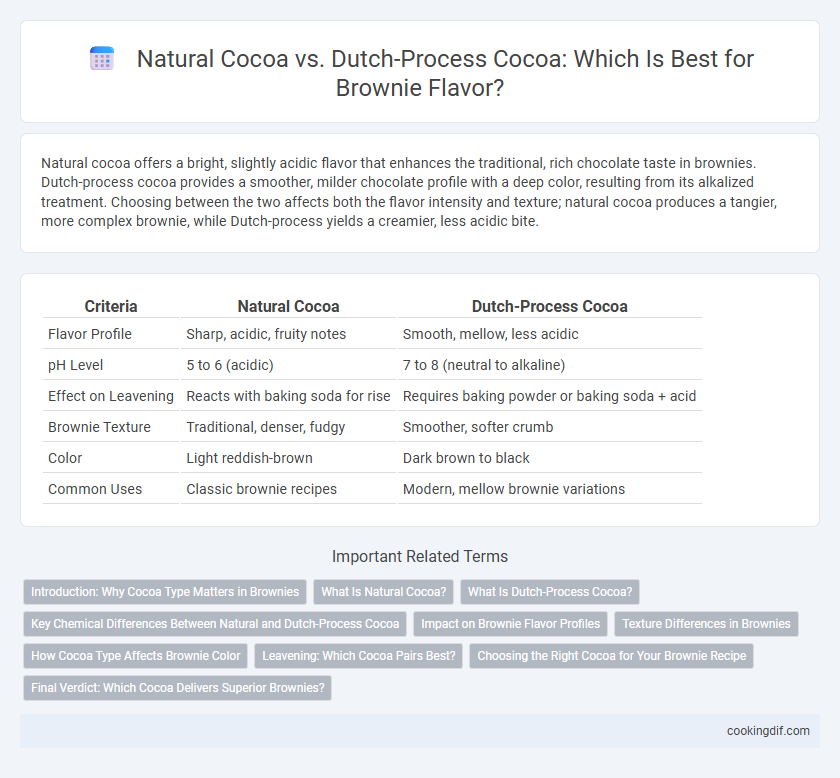Natural cocoa offers a bright, slightly acidic flavor that enhances the traditional, rich chocolate taste in brownies. Dutch-process cocoa provides a smoother, milder chocolate profile with a deep color, resulting from its alkalized treatment. Choosing between the two affects both the flavor intensity and texture; natural cocoa produces a tangier, more complex brownie, while Dutch-process yields a creamier, less acidic bite.
Table of Comparison
| Criteria | Natural Cocoa | Dutch-Process Cocoa |
|---|---|---|
| Flavor Profile | Sharp, acidic, fruity notes | Smooth, mellow, less acidic |
| pH Level | 5 to 6 (acidic) | 7 to 8 (neutral to alkaline) |
| Effect on Leavening | Reacts with baking soda for rise | Requires baking powder or baking soda + acid |
| Brownie Texture | Traditional, denser, fudgy | Smoother, softer crumb |
| Color | Light reddish-brown | Dark brown to black |
| Common Uses | Classic brownie recipes | Modern, mellow brownie variations |
Introduction: Why Cocoa Type Matters in Brownies
Natural cocoa delivers a sharp, fruity acidity that enhances complexity in brownies, while Dutch-process cocoa offers a mellow, smooth profile due to its alkalization. The choice between these cocoa types directly influences the chemical reaction with leavening agents, affecting the brownie's texture and rise. Understanding these differences allows bakers to tailor flavor intensity and crumb structure for the perfect brownie experience.
What Is Natural Cocoa?
Natural cocoa is pure cocoa powder made from roasted cacao beans without any alkali treatment, preserving its naturally bitter and fruity flavor profile. It has a lower pH, typically around 5 to 6, which reacts with baking soda to create leavening in brownie recipes, resulting in a tender crumb. Its intense, robust chocolate taste makes it ideal for traditional brownie recipes seeking a deep, authentic cocoa flavor.
What Is Dutch-Process Cocoa?
Dutch-process cocoa, also known as alkalized cocoa, undergoes treatment with an alkalizing agent to neutralize its natural acidity, resulting in a smoother, mellower flavor and darker color compared to natural cocoa. This process reduces the cocoa powder's bitterness and enhances its solubility, making it ideal for richer, more consistent brownie textures and flavors. In brownie recipes, Dutch-process cocoa contributes to a deep chocolate taste and a tender crumb, while natural cocoa offers a tangier, more acidic profile that interacts differently with leavening agents.
Key Chemical Differences Between Natural and Dutch-Process Cocoa
Natural cocoa contains higher acidity with a pH between 5 and 6, contributing to a bright, tangy flavor and activating baking soda for leavening in brownies. Dutch-process cocoa is alkalized to neutralize acidity, raising its pH to about 7 or 8, resulting in a smoother, milder taste and requiring baking powder or baking soda combined with an acid for proper rise. The chemical difference in acidity between these cocoas significantly impacts the flavor profile and texture of brownies.
Impact on Brownie Flavor Profiles
Natural cocoa delivers a sharp, fruity acidity that enhances the complexity and brightness of brownie flavors, creating a more intense chocolate experience. Dutch-process cocoa is alkalized to neutralize acidity, producing a smoother, milder taste with deeper, earthier chocolate notes that result in a richer, more balanced brownie profile. The choice between natural and Dutch-process cocoa directly influences the brownie's flavor intensity and mouthfeel, making it crucial for achieving the desired taste profile.
Texture Differences in Brownies
Natural cocoa produces brownies with a lighter, more crumbly texture due to its higher acidity, which reacts with baking soda to create lift. Dutch-process cocoa, being alkalized and less acidic, yields a smoother, denser, and fudgier brownie texture by reducing leavening reactions. These texture differences directly impact the final mouthfeel and richness of brownies, depending on the type of cocoa powder used.
How Cocoa Type Affects Brownie Color
Natural cocoa powder contains higher acidity, which creates a reddish-brown hue in brownies, highlighting a more vibrant and traditional color. Dutch-process cocoa is alkalized, neutralizing acidity and resulting in a darker, richer brown shade that deepens the visual appeal of the brownies. The choice between natural and Dutch-process cocoa significantly influences the brownie's final color, with natural cocoa offering a lighter tone and Dutch-process providing a denser, chocolatey appearance.
Leavening: Which Cocoa Pairs Best?
Natural cocoa, with its acidic properties, reacts vigorously with baking soda to create a strong leavening effect, resulting in a lighter, airier brownie texture. Dutch-process cocoa is alkalized, neutralizing its acidity, so it pairs better with baking powder for leavening, leading to a denser, fudgier brownie. Understanding the leavening interaction with each cocoa type is crucial for achieving the desired balance of flavor and texture in brownies.
Choosing the Right Cocoa for Your Brownie Recipe
Natural cocoa provides a bright, fruity acidity that enhances the rich, deep chocolate flavor in brownies, making it ideal for recipes relying on baking soda for leavening. Dutch-process cocoa offers a smoother, milder taste with less acidity, perfect for dense, fudgy brownies that use baking powder or no leavening agent. Selecting the right cocoa depends on your desired texture and flavor profile, as natural cocoa creates a sharper taste while Dutch-process yields a more mellow, chocolatey experience.
Final Verdict: Which Cocoa Delivers Superior Brownies?
Dutch-process cocoa delivers superior brownies with a smoother, less acidic flavor and a richer, darker color, enhancing the overall taste and texture. Natural cocoa offers a fruity, more robust tang but can result in slightly grainier or lighter-colored brownies when baked. Choosing Dutch-process cocoa typically yields a more consistent, decadent brownie experience favored by professional bakers.
Natural cocoa vs Dutch-process cocoa for brownie flavor Infographic

 cookingdif.com
cookingdif.com